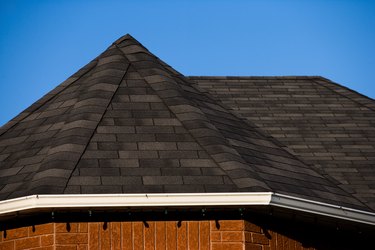
The pitch or slope of the roof is the amount it rises to its peak as it moves horizontally. Pitch is typically expressed as a ratio of the number of rising units to the number of 12 horizontal units since there are 12 inches to a foot. So, a roof that rises 3 inches for every 12 inches has a 3:12 pitch. In Massachusetts, minimum roof pitch must take into account the roofing material and is defined by the state Department of Public Safety.
Codes
Video of the Day
As with the building authorities in nearly all states, cities and towns across the U.S., Massachusetts bases its construction regulations on the International Residential Code (IRC). The International Code Council maintains this standard among several others, such as the International Fire Code and the International Energy Conservation Code. This non-profit member organization was founded in 1994 to resolve conflict and eliminate duplication among the different building regulations existing at the time. Though most building authorities use the latest version of the IRC, Massachusetts relies on the 2009 edition with amendments that the state issues yearly. However, few of the amendments affect roofing, and none affects roof pitch.
Video of the Day
Asphalt
The pitch of a roof depends entirely on the type of covering. For asphalt shingles, which are popular because of their ease of installation, durability and low cost, the minimum pitch is 2:12 on a roof deck that must be solidly sheathed. Slopes from 2:12 to 4:12 need double underlayment for maximum waterproofing. This means two layers of roofing paper must be attached to the roofing deck and under the shingles.
Wood
Wood shakes, which have a rough surface, add dimension and visual warmth to a roof but require refinishing and constant maintenance. Wood shakes can use solid or spaced sheathing. The minimum pitch is 3:12. Wood shingles, which have a smoother and more refined appearance, have the same requirements for decking and underlayment as shakes, along with the same minimum pitch of 3:12.
Tile
Tile made of either clay or concrete is long-lasting, fire-resistant and naturally impervious to mold, rot and insect damage. It requires either solid sheathing or spaced structural sheathing. The minimum roof pitch is 2.5:12. Roof slopes from 2.5:12 to 4:12 require double underlayment.
Metal
Metal roofs are available in two varieties: shingle and panel. Shingles can accept surface texturing so they look like other materials from a distance and are inherently fire-resistant and impervious to the weather. They need a solid or closely fitted deck, unless specifically manufactured for space sheathing. The minimum roof pitch is 3:12. Metal panels are popular with modern homes because of their continuous appearance. They have the same deck requirements as shingles. If they are lapped with non-soldered seams and no lap sealant, then the minimum pitch is 3:12. If they have lap sealant, then the minimum slope is 0.5:12. For metal roofs with standing seams, the minimum slope is 0.25:12, which is nearly flat.